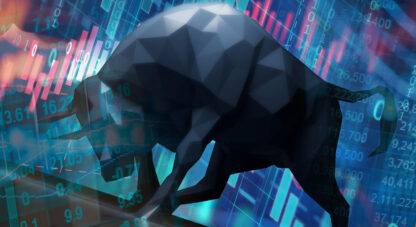A Chat with Danielle DiMartino Booth
HAI has a rare treat for readers this week. Danielle DiMartino Booth may be the closest thing to a rock star the “dismal science” of economics and the world of central banking have these days. She is a highly respected global thought leader in monetary policy, economics, and finance, and she delivers her expert analysis with a bold, colorful candor that’s as big as her home state of Texas.
Danielle is the founder of QI Research, the author of FED UP: An Insider’s Take on Why the Federal Reserve is Bad for America, and you’ve likely seen her shrewd analysis in countless interviews with all major media outlets.
Her economic analysis and Federal Reserve critique come with authority and an insider’s insights. She spent nine years at the Federal Reserve Bank of Dallas, where she served as Advisor to President Richard W. Fisher throughout the great financial crisis until his retirement in 2015. Her work at the Fed focused on financial stability and the efficacy of unconventional monetary policy. HAI hopes readers enjoy this interview with Danielle as much as this author enjoyed conducting it.
HAI: Danielle, thank you so much for joining Hard Asset Insights this week. It’s a real pleasure to chat.
For the last couple of years we’ve had volatile, mixed, and in some cases conflicting economic data. We’ve had varying degrees of disagreement between the ISM and S&P PMIs, we’ve had conflicting labor market data. What are you seeing in the economic data that gives you confidence a recession has likely already started, and that the hard part of a hard landing is still ahead of us?
Danielle: Well, I think it’s really just a matter of contrasting soft survey data from the Bureau of Labor Statistics [non-farm payrolls] with hard data that’s gathered by the Census Bureau [the Quarterly Census of Employment & Wages (QCEW)] on a quarterly basis and released with quite the lag. We know from the Census data that there was a net job loss of negative 192,000 in the three months ended September 30th, 2023, so typically when you start to see net job losses you are in the teeth of recession—historically speaking, of course. It could always be different this time, but that really is what I’m going off of [the more accurate hard data reported by the Census vs. non-farm payrolls], and it’s based on what US employers have actually reported as their headcount.
HAI: The market seems to have developed a Pavlovian response to weak economic data, having learned that weak data leads to rate cuts and stimulus. So, perversely, bad news is good news—not on Main Street, but on Wall Street. Do you see that continuing to play out, or are markets in for an unpleasant surprise?
Danielle: I’m not a crystal ball person myself, but post-war history does dictate that it’s not until the Fed actually lowers interest rates that the stock market corrects, so the market should rally into the first Fed rate cut and then correct, if history is any precedent. That’s how it’s gone in the past.
HAI: What do you think Jay Powell wants or needs to see before he starts cutting rates?
Danielle: I think that Powell is motivated by factors that are well beyond what is in the US economy today. I think he has his eye on some very far-reaching regulations of the non-banks, and in order to achieve these higher goals he’ll have to have a higher-for-longer policy as long as possible, even if it means he has to look past weak data for a time. I think until he sees 300,000 every week on initial jobless claims and/or we see a continued rise in the unemployment rate— Of course the unemployment rate hit the Fed’s 2024 year-end target for the unemployment rate in May at 4.0%; it then surpassed it in June by hitting 4.1%. So it’s going to be increasingly difficult—especially with downward revisions to past data showing that there have been net job losses—it will be increasingly difficult for Powell to maintain his higher-for-longer stance as the unemployment rate continues to rise. And we know that will be the case because announced job cuts have not fallen off seasonally as they typically do after January.
HAI: As far as Powell’s interest in the non-bank sector specifically, what’s on your mind there?
Danielle: Well, it’s called Basel III Endgame (B3E). Ever since Dodd-Frank accelerated the growth of the non-banking sector by encouraging speculation to leave the conventional banking system— Globally that’s a $180 trillion dollar system, and now of course the non-banking system is much larger than that at $240 trillion, but wholly unregulated. So I think his goal really is much loftier in the sense that he has his eye on beginning to rein-in and regulate that non-banking—shadow banking sector, sometimes it’s called.
HAI: The recent history is that when the Fed starts cutting interest rates, they cut aggressively and juice the market with stimulus. However, this time, you’re skeptical that Powell will go back to the zero-bound [zero interest rate policy] on rates. What’s different with this Jay Powell versus previous Fed-heads and even previous versions of Jay Powell himself?
Danielle: You know, I think we have to bear in mind how very different an individual this Jay Powell is compared to those who’ve preceded him in the position. I can’t emphasis enough just how much he’s been up to the Hill more than any of his predecessors, meeting with people on both sides of the isle. I’m not talking about visiting with the president—in fact, quite the opposite. I’m talking about visiting with members of Congress on both sides of the isle. He’s been much more proactive than his predecessors, and he’s much less malleable politically compared to his predecessors as well. He’s got a net worth upwards of $150 million, so he certainly doesn’t need a salary, so I think he’s there for a much different reason. I think Jay Powell is one of the most misunderstood individuals right now in a position of leadership in the United States.
HAI: Okay, so if that’s correct and Jay Powell cuts rates from current levels, but then holds those rates at a higher floor than previous cycles and refuses to fully reinstate zero-interest rate policy, do you think that’s a looming and impactful negative surprise for financial markets?
Danielle: Yes, possibly. Powell has indicated—some of his closest lieutenants, Christopher Waller—they have indicated that the zero-bound policy is a failed one. They’ve indicated that the Fed making a foray into mortgage backed securities and quantitative easing was a failure. These are massive philosophical differences between Powell and ‘the Bernanke doctrine’ that dictated that quantitative easing could not be launched until the federal funds rate was at the zero bound. I don’t think that Powell buys into that philosophically, and a lot of business models—especially in the non-banking system—are predicated on and in fact are designed around a zero-interest rate policy as the working assumption.
HAI: John Hussman recently warned that, by his calculus, he sees 50% to 70% downside vulnerability in the S&P 500 over the remainder of this cycle. Do you see your recession call as more of an economic event than a market event, or do you think that a recession will ultimately play out quite negatively for financial markets?
Danielle: It’s very difficult to say how financial markets are going to react or the extent to which they will react, but what I can tell you is that once we’ve crossed a certain threshold with the unemployment rate and with the loss of full-time jobs in the United States, on average the S&P 500 correction is 32.9%. So that’s what we know historically to be the case. If it’s going to be deeper than that, as John Hussman indicates, that would suggest that the stock market is reliant on the zero bound in order to rebound; and that if we are going to stop at say 2.9%, 3.0%, 3.1%, or whatever it may be on the federal funds rate [though] stocks require 0% to resume a rally, then we may indeed have a more protracted downturn in the stock market than what this current generation of investors is accustomed to seeing.
HAI: Any specific thoughts on precious metals amid the turbulence you see coming?
Danielle: Well, I do think the word turbulence and precious metals tend to go hand-in-hand, right? One benefits the other, traditionally, whether or not you’re in an inflationary or a deflationary environment.
HAI: So, do you anticipate an inflationary or deflationary environment? Also, any thoughts on US debt and deficits and the risks they pose to ongoing business-as-usual in Washington? I’d love to pull that thread.
Danielle: Well, when you look underneath the hood and see, at the margin, where deficit spending is occurring, it’s increasingly earmarked to servicing the debt. In terms of fresh fiscal spending, we haven’t seen that.
Now, if Washington policymakers were going to provide fresh fiscal stimulus, that would be different. Of course, the first real opportunity would be in February/March/April of 2025. If that fresh fiscal stimulus delivered in, say, the spring of 2025 is in the form that the post-pandemic stimulus assumed—in other words bypassing the banking system: helicopter money directly delivered to individuals, individual US households, and businesses in direct deposits pumped into the economy—that would immediately regenerate the double-digit inflation that we saw previously.
In other words, the interest component on the debt alone isn’t going to stimulate inflationary impulses if you’re not creating fresh fiscal stimulus. So, unless we have that transmission mechanism, you’re not going to create that inflation that goes along with it.
HAI: There is the risk that the burgeoning interest expense on $35 trillion of government debt fuels a debt spiral. Does that risk, in and of itself, put pressure on Powell to cut rates regardless of inflation and regardless of whether the economy weakens materially?
Danielle: I don’t think Powell is a political animal. I believe that. If Powell prevents a return to the zero-bound, let’s just say that the fed funds rate theoretically stops somewhere in the 2% range, that’s going to remain a debilitating factor for our US government servicing that debt.
HAI: Hey, thank you so much for joining HAI today, Danielle!
* * *
HAI really enjoyed speaking with Danielle. She packed a lot into a short interview. So this author will recap (HAI’s interpretation) her key message.
She offered the rationale for her recession call. She pointed out that, based on history, the market likely won’t correct until the Fed cuts rates, but again based on history, that correction averages negative 32.9%. She said that she expects initial jobless claims reaching 300,000 per week and any further increase in the unemployment rate would be the trigger for Jay Powell’s rate cuts and the expected subsequent market correction. Furthermore, she noted that she expects those conditions to be met soon, as announced job cuts this year have not fallen off seasonally as they typically do after January. She also went on to explain that, in her view, the outlook for either inflation or deflation rests solely on the shoulders of politicians. If D.C. policymakers once again ramp-up direct fiscal spending post-Covid style after the election, then we can expect another inflationary impulse. If they don’t, in a recessionary environment, we should be clear of a second inflationary impulse.
In addition, Danielle discussed her impression that Powell is motivated by “higher goals” than merely the Fed’s mandate on inflation and unemployment. She went so far as to say that, in her view, Jay Powell is “one of the most misunderstood individuals right now in a position of leadership in the United States.”
She gives several examples of his higher goals. 1) Danielle suggests that Powell wants to see the $240 trillion non-bank (“shadow banking”) sector regulated. Presumably, in HAI’s best interpretation, she thinks Powell’s higher-for-longer interest rate policy is partially intended to cause turmoil in that shadow banking sector. The implication is that if the shadow banking sector is squeezed by higher rates for longer, the resulting fallout will aid regulators with a cause that will act as a catalyst for effective regulation of the sector. 2) Danielle believes that Powell is opposed to zero-interest rate policy philosophically. She suspects that at this point in his tenure, while he will cut rates from the current level, he won’t return rates to the zero-bound. That could be an unpleasant surprise for portions of the economy built for a 0% interest rate world. Furthermore, that could be a catalyst to deepen the expected sell-off in the stock market beyond the historical average of 32.9% post recessions.
3) Lastly, and perhaps most importantly in HAI’s opinion, Danielle in her last response to the question on debt and deficits seemed to insinuate that Powell clearly understands that zero-interest rate policy enables the inflationary deficit spending tendencies of Washington politicians. Powell has said numerous times that Washington fiscal policy is “unsustainable.” Danielle, however, in HAI’s view, seemed to suggest that part of Powell’s motivation for not returning to the zero-bound is to maintain interest rates as a “debilitating factor for our US government servicing that debt.” In other words, if HAI is interpreting correctly, Danielle is suggesting that, like the bond vigilantes of yesteryear, Powell wants to use interest rates to discipline lawmakers away from the devastatingly unsustainable path of ruinous deficit largess. We can all hope!
Again, HAI hopes all readers enjoyed the interview as much as this author did! HAI Readers can follow Danielle on Twitter/X at the handle @DiMartinoBooth. Readers can also access more of Danielle’s industry leading research at quillintelligence.com.
Weekly performance: The S&P 500 was down 1.97%. Gold was off 0.89%, silver was crushed by 5.98%. Platinum was off 3.89%, and palladium was crushed by 7.20%. The HUI gold miners index was down 1.45%. The IFRA iShares US Infrastructure ETF was strong, up 1.98%. Energy commodities were volatile and down on the week. WTI crude oil was down 4.34%, while natural gas was off 8.63%. The CRB Commodity Index was off 3.47%. Copper was crushed by 7.76%. The Dow Jones US Specialty Real Estate Investment Trust Index was up 0.53%. The Vanguard Utilities ETF lost 1.22%. The dollar index was up 0.32% to close the week at 104.11. The yield on the 10-yr U.S. Treasury was up 5 bps to close at 4.24%.
Have a wonderful weekend!
Best Regards,
Morgan Lewis
Investment Strategist & Co-Portfolio Manager
MWM LLC















